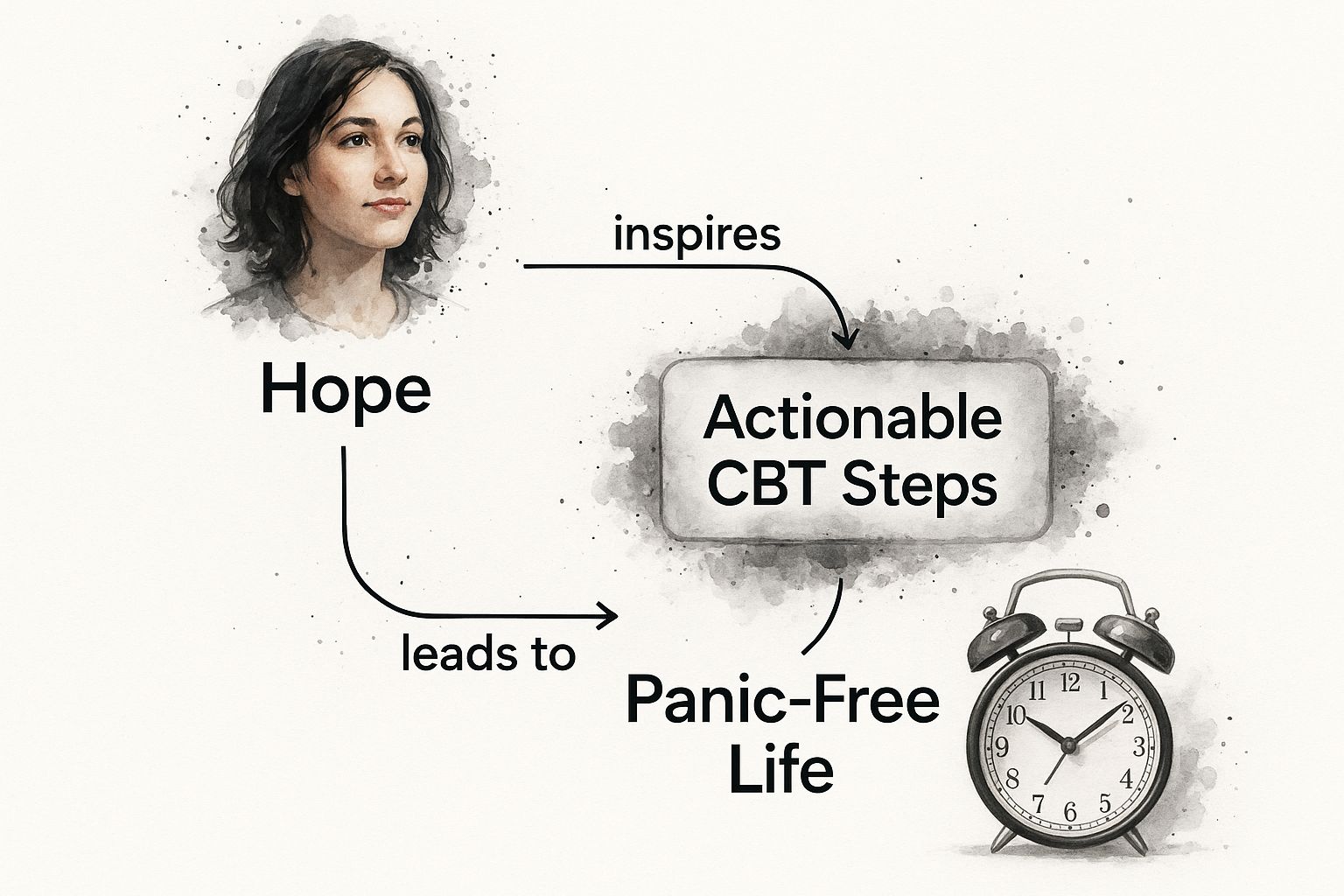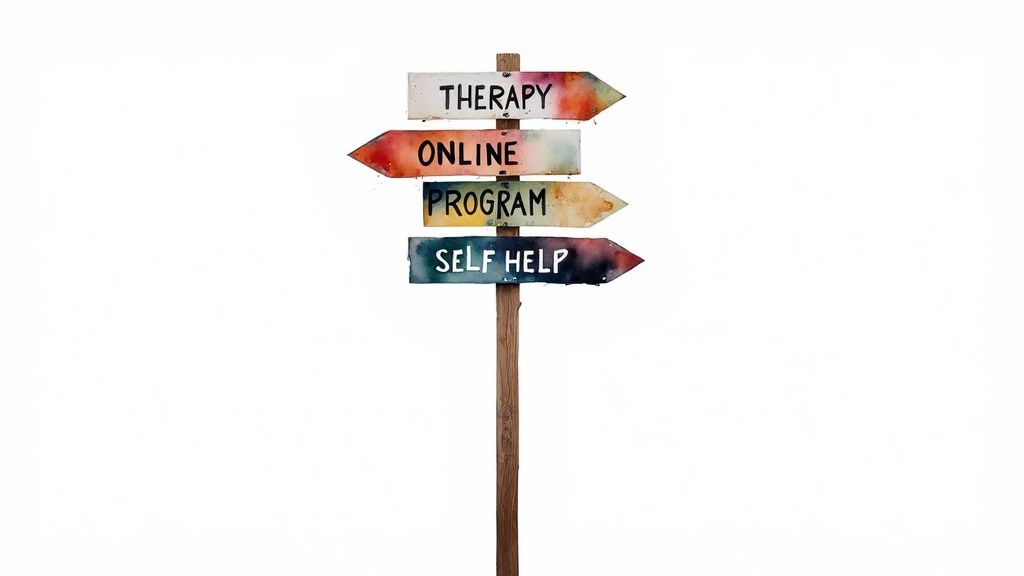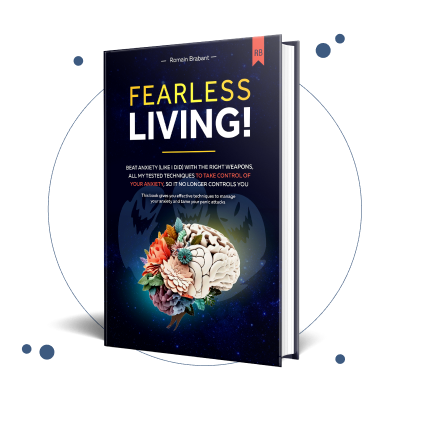
If you're living with the constant fear of the next panic attack, I want you to know something important: you are not alone, and you don't have to feel this way forever. This guide is built on a foundation of hope, introducing Cognitive Behavioral Therapy (CBT) as a proven, practical roadmap to reclaim your life from panic. It’s here to show you that a calmer, more peaceful existence isn't just a possibility—it's a destination you can absolutely reach.
Your Path to a Panic-Free Life Begins Now
Living with panic disorder can feel like you're trapped on high alert, always bracing for the next wave of overwhelming fear. The physical sensations—a racing heart, shortness of breath, dizziness—are so intense they can trick you into thinking you’re in real danger. It’s a terrifying experience, and it can make you feel utterly powerless.
This often creates a vicious cycle where you start to fear the fear itself. Your world might start to shrink as you begin avoiding places and situations you link with panic.
But here’s the most important truth: panic disorder is highly treatable. You do not have to live this way forever. Cognitive Behavioral Therapy (CBT) isn't just about coping; it's a structured, skill-based approach designed to fundamentally change your relationship with anxiety. It gives you a clear path forward, empowering you to understand and manage the very sensations that feel so out of control, ultimately leading you to a life lived without fear.
A Proven Framework for Lasting Change
The power of CBT isn't just based on hopeful stories; it’s one of the most well-researched therapies for anxiety disorders. Study after study confirms that CBT has a significant, lasting impact on panic disorder, with many people remaining panic-free long after their sessions end. This success comes from its direct, empowering approach: getting to the root of the panic cycle and dismantling it piece by piece, giving you back control.
This infographic helps visualize the journey from hope to healing with CBT.

As you can see, hope is the starting point, but when you combine it with the practical, actionable strategies of CBT, you create a direct route toward a life that isn't ruled by panic.
At its core, CBT teaches you a new, more powerful way to respond to both your thoughts and your body's signals. Instead of interpreting a rapid heartbeat as a sign of a catastrophe, you will learn to see it for what it is: a harmless—though admittedly uncomfortable—sensation. This single shift in perspective is the key to breaking free and reclaiming your peace.
To get a better handle on the physical feelings that kickstart this cycle, our guide on what happens during a panic attack can offer some valuable insights.
To give you a clearer picture of how this all works together, here’s a quick breakdown of the core components of CBT and what they mean for you on your journey to a full recovery.
| Core Component | What It Means For You | The Ultimate Goal |
|---|---|---|
| Cognitive Restructuring | Learning to identify and challenge the catastrophic thoughts that fuel panic. | To see scary thoughts as just thoughts—not facts—and replace them with balanced, realistic ones, restoring your inner calm. |
| Interoceptive Exposure | Gently and safely facing the physical sensations you fear (like a racing heart or dizziness). | To teach your brain that these feelings are not dangerous, so you can live without fear of your own body. |
| Behavioral Experiments | Actively testing your fearful beliefs to see if they hold true in the real world. | To gather direct evidence that your fears are unfounded, building unshakable confidence and courage. |
| Relaxation Techniques | Mastering skills like deep breathing and progressive muscle relaxation. | To calm your nervous system in the moment and feel in control of your physical state. |
Each of these pieces works together, creating a powerful toolkit that doesn't just help you manage panic—it empowers you to overcome it. It’s about building a new relationship with your body and mind, one grounded in understanding and self-trust rather than fear, paving the way for a panic-free future.
How CBT Breaks the Vicious Cycle of Panic
Panic attacks often feel like they strike from nowhere. One minute you're fine, the next you're spiraling—completely overwhelmed and terrified. But what if I told you they aren't random at all?
In reality, panic follows a predictable pattern. It's a vicious cycle that feeds on itself, and understanding this pattern is the very first step toward breaking free. This is the cornerstone of CBT for panic disorder, and it’s how you take your power back.

Think of your body’s internal alarm system like an overly sensitive car alarm. A gentle breeze or a passing cat shouldn't set it off, but yours does, blaring loudly at the slightest provocation. This is exactly what’s happening during a panic attack; a perfectly harmless internal signal gets misinterpreted as a major threat.
This tiny misinterpretation kicks off a powerful feedback loop that can feel impossible to escape. But once you see the mechanics behind it, you realize you can intervene. The cycle isn't some unbeatable monster; it's a process with clear stages, and CBT gives you the tools to disrupt each one, giving you the upper hand.
The Four Stages of the Panic Cycle
The panic cycle typically unfolds in four distinct steps, each one ramping up the fear and convincing your brain that something is terribly wrong. By mapping this sequence, you can finally see exactly where—and how—to get back in the driver's seat. Demystifying the experience like this is one of the most powerful and hopeful aspects of using CBT for anxiety.
The good news? Its predictability means your panic isn't random. It's a pattern. And patterns can be unlearned. You can heal.
Let’s break down the four stages that create this powerful loop:
- The Trigger Sensation: It all starts with a perfectly normal physical sensation. Maybe your heart rate ticks up after climbing some stairs. Maybe you feel a little dizzy standing up too fast, or a bit breathless in a stuffy room. These are harmless, everyday bodily functions.
- Catastrophic Misinterpretation: This is where the alarm gets tripped. Instead of recognizing the sensation as normal, your mind leaps to the worst possible conclusion. "My heart is racing—I must be having a heart attack!" or "I feel dizzy—I'm going to faint or lose control!" This catastrophic thought is the fuel that ignites the panic.
- The Surge of Fear and Anxiety: Believing it’s in mortal danger, your brain floods your system with adrenaline. This "fight-or-flight" response is designed to save you from a real threat, but here, it’s a false alarm. You get hit with a powerful wave of intense fear, dread, and pure terror.
- Amplified Physical Symptoms: That adrenaline surge creates very real, very scary physical symptoms. Your heart pounds even faster. Your breathing becomes shallow. You might start sweating, trembling, or feeling tingling sensations. Crucially, these new symptoms seem to confirm your initial catastrophic thought, creating a self-fulfilling prophecy that locks you into the cycle.
This feedback loop—sensation, thought, fear, more sensation—can spiral into a full-blown panic attack in minutes. The experience is so intense that it leaves you fearing not just the sensations themselves, but the fear of the fear. This is what leads to avoidance and, for many, a shrinking world.
Your First Step Toward Breaking the Cycle
Just recognizing this pattern is a complete game-changer. It shifts panic from a mysterious force that controls you into a psychological process you can actually influence and overcome. The goal isn’t to stop the initial sensations—those are normal—but to change how you interpret them.
The core of CBT for panic disorder is learning that your fear is the problem, not the physical symptoms. By changing your relationship with the sensations, you starve the panic cycle of its fuel and set yourself free.
This understanding is your entry point to lasting recovery. From here, CBT provides structured techniques to challenge those catastrophic thoughts and safely reacquaint yourself with the physical feelings you’ve learned to fear, proving to yourself that you are safe and in control.
You learn to see a racing heart as just that—a racing heart—not a sign of imminent doom. This cognitive shift is the key that unlocks the cage, offering a clear, achievable path toward living without constant fear.
Your Toolkit for Reclaiming Control and Calm
Knowing what the panic cycle is is one thing; taking your life back from it is another. This is where Cognitive Behavioral Therapy (CBT) truly shines—it gives you a practical, hands-on toolkit to put you back in the driver's seat. These aren't just abstract theories. They're real techniques you can learn, practice, and master to dismantle panic from the inside out and build a life of freedom.
Think of it like learning to drive. At first, you're hyper-aware of every single action—checking mirrors, pressing pedals, signaling. It feels clunky and overwhelming. But with practice, it all smooths out and becomes second nature. The tools in CBT work the exact same way, empowering you to become the authority over your own mind and body again.

This section walks you through the core strategies that will become the heart of your recovery. Each one is a powerful tool designed to step in at a different point in the panic cycle, giving you multiple ways to find your footing and build lasting, unshakable confidence.
Rewiring Your Thoughts with Cognitive Restructuring
The engine that powers the panic cycle is catastrophic thinking. It starts with a completely harmless physical sensation, but your mind immediately leaps to the absolute worst-case scenario. Cognitive Restructuring is the skill of learning to catch, challenge, and change these automatic negative thoughts. It's not about forcing "positive thinking," but about learning to see the situation realistically and compassionately.
Imagine your catastrophic thought is a prosecutor in a courtroom, making a dramatic, one-sided case that you're in immediate danger. Cognitive restructuring is like bringing in your own defense attorney—someone who calmly examines the evidence, questions the wild assumptions, and presents a more balanced, logical alternative that sets you free.
It starts with spotting the specific thoughts that kick off your fear. For example:
- The Thought: "My chest is tight. This is a heart attack."
- The Challenge: "Hang on. I've felt this before, and my doctor said my heart is healthy. It's way more likely to be anxiety. What else could it be? Maybe just muscle tension from a stressful day."
- The Reframe: "This feeling is uncomfortable, but it's not dangerous. It's a symptom of anxiety, and I know it will pass. I am safe."
This process directly cuts off the fuel supply for panic. By consistently questioning these misinterpretations, you're actively retraining your brain to stop sounding that false alarm, creating a new default response of calm and self-assurance. For a wider view on managing anxiety, this guide to finding your calm offers some great perspectives.
Facing Your Fears Safely with Interoceptive Exposure
One of the most powerful—and often misunderstood—tools in CBT is Interoceptive Exposure. The name might sound intense, but it's a gentle, safe, and incredibly effective way to overcome the fear of your own physical sensations. Think of it as exposure therapy for your body's false alarms, designed to prove your own resilience.
The goal is simple: to prove to your brain, through direct experience, that feelings like a racing heart, dizziness, or shortness of breath are not dangerous. Under the guidance of a therapist (or very carefully on your own), you intentionally and safely bring on the very sensations you're afraid of in a controlled, supportive setting.
By voluntarily creating these sensations, you strip them of their power. You move from being a victim of your symptoms to being in control of them, which is a profoundly empowering and liberating shift.
This is done through a series of small, manageable exercises. For instance, to get used to the feeling of a rapid heartbeat, you might jog in place for 30 seconds. To tackle dizziness, you might spin in a chair for a short period. You learn, time and time again, that while the sensations are real, the catastrophic outcome you fear never actually happens. This builds a deep, unshakable trust in your body's strength.
Grounding Yourself with In-the-Moment Calming Techniques
While restructuring your thoughts and facing your fears are long-term game-changers, you also need tools for the here and now. Calming techniques are your first-aid kit for moments of high anxiety, helping you soothe your nervous system before the panic cycle can truly take hold and reminding you of your own ability to create calm.
The most effective of these is diaphragmatic breathing, or belly breathing. When we start to panic, our breathing becomes shallow and quick, which actually makes physical symptoms like dizziness and tingling worse. Diaphragmatic breathing does the exact opposite.
By taking slow, deep breaths that engage your diaphragm, you activate the body's natural relaxation response. This sends a powerful signal to your brain that the danger has passed, helping to counteract the adrenaline rush. Getting the basics right is crucial, and you can explore different breathing exercises for anxiety to see which ones feel best for you.
Putting these tools into practice is where the real transformation happens. Here’s a quick breakdown to help you build your personal CBT toolkit and know when to reach for each strategy on your path to healing.
Your CBT Toolkit for Managing Panic
| Technique | Primary Purpose | Best Used When… |
|---|---|---|
| Cognitive Restructuring | To challenge and change the catastrophic thoughts that fuel panic. | Daily, as a preventative skill, and during the initial stages of rising anxiety to restore calm. |
| Interoceptive Exposure | To reduce the fear of physical panic symptoms through safe, repeated practice. | In planned, structured sessions to build long-term resilience, tolerance, and freedom from fear. |
| Calming Techniques | To manage acute anxiety and ground yourself in the present moment. | At the first sign of anxiety or during a panic attack to de-escalate symptoms and regain control. |
By building this toolkit, you are actively creating a future where you are no longer at the mercy of panic. Each time you challenge a thought, practice an exposure exercise, or use your breath to calm your body, you are casting a vote for a life defined by freedom, not fear.
What Your CBT Journey Actually Looks like
Knowing the tools of Cognitive Behavioral Therapy is one thing. Actually picturing how they all come together to build a life free from panic? That's something else entirely.
This isn't a vague, abstract process. It's a structured, supportive, and often empowering adventure that turns theory into tangible action, one manageable step at a time.
Think of it like learning to navigate with a map and compass. At first, it might feel a little clunky. But soon enough, you start recognizing the landmarks, trusting your tools, and feeling a growing sense of confidence that you can find your way, no matter the terrain. Your CBT for panic disorder journey follows a similar path, building skills and confidence until you are the one in control, not the fear.
This path is paved with hope because it's built on a well-researched, proven process. It's about actively participating in your own healing, armed with a clear plan and the knowledge that countless people have walked this path before you and found lasting, life-changing relief.
The First Step: Becoming a Detective of Your Own Mind
Your journey begins not with a grand confrontation, but with quiet observation. The first phase of CBT is all about self-monitoring—becoming a curious detective investigating your own patterns of thought, feeling, and behavior. This is where you start to really see the panic cycle in your own life.
A therapist will introduce you to a foundational tool, often called a thought record or a panic diary. This isn't just a journal for venting. It's a structured worksheet designed to help you connect the dots between your physical sensations, automatic thoughts, and emotional responses.
You'll start by logging your panic attacks or moments of high anxiety, noting key details:
- The Situation: Where were you? What was going on? (e.g., "Driving on the highway.")
- Physical Sensations: What did you feel in your body? (e.g., "Heart started racing, felt dizzy.")
- Automatic Thoughts: What was the very first thing that shot through your mind? (e.g., "I'm going to crash," or "I'm losing control.")
- Feelings: What emotions came up, and how intense were they? (e.g., "Terror, 9/10.")
This initial step is incredibly illuminating. For the first time, you might see clear patterns emerge, transforming panic from a random, terrifying monster into a predictable, understandable process. This act of tracking alone can bring a huge sense of control and demystify the experience, which is a massive first step toward healing.
Learning to Question the Alarm Bells
Once you've identified those catastrophic thoughts that fuel your panic, the next phase is all about learning to gently and systematically challenge them. This is the heart of cognitive restructuring. Your therapist acts as a guide, helping you question the validity of those knee-jerk, fearful thoughts and discover your own inner wisdom.
Let's take the catastrophic thought: "My heart is pounding, I'm definitely having a heart attack." Together, you'd start to examine the evidence, almost like a friendly lawyer cross-examining a panicked witness.
You’ll learn to ask yourself gentle but firm questions: "What's the evidence for this thought? What's the evidence against it? What's a more likely, less scary explanation for my racing heart?" This process teaches you to find a more balanced, realistic perspective instead of instantly jumping to the worst-case scenario.
This isn't about telling yourself you're wrong or silly; it's about expanding your perspective. You learn to generate alternative interpretations. For example, "My heart is pounding because I'm anxious and my adrenaline is high. It’s uncomfortable, but it’s not dangerous. It will pass."
Each time you do this, you weaken the automatic link between a physical sensation and a full-blown panic reaction, creating new, healthier neural pathways based on calm and truth.
Reclaiming Your Body and Your Life Through Exposure
The final—and perhaps most empowering—stage of the journey is exposure. This is where you prove to your brain, through direct experience, that you are safe and capable. Guided by your therapist, you will gradually and safely face the very things you've been avoiding—both the physical sensations themselves and the real-world situations that trigger them.
This process always starts small, with steps that feel totally manageable. The goal is to build a foundation of success and confidence, one victory at a time.
- Interoceptive Exposure: You'll start with exercises designed to bring on mild physical sensations in a controlled environment. For instance, you might run in place for 30 seconds to feel a racing heart or breathe through a thin straw to notice a change in your breathing. You learn firsthand that these feelings, on their own, are harmless.
- In-Vivo Exposure: Next, you'll create a "fear ladder" of situations you've been avoiding. If you're afraid of driving, you might start by just sitting in the parked car in your driveway. From there, you'd progress to driving around the block, then on a quiet street, and eventually, onto the highway. Each step is a celebration of your growing courage.
This phase is all about collecting new evidence—evidence that you can handle these situations and that your feared catastrophes don't actually happen. It's an incredibly powerful way to rebuild trust in yourself and your body. To better understand how this works, you can read more about the principles of exposure therapy for anxiety.
This structured, step-by-step approach ensures you never feel overwhelmed, building a lasting sense of mastery and the freedom to live your life fully.
How to Find the Right Treatment and Support
Taking that first step toward getting help is a huge act of courage and hope. It’s you telling yourself that you’re ready for a life where fear doesn't call the shots, and you deserve to feel proud of that. This section is your practical guide for navigating what comes next, helping you find a treatment path that fits your life, needs, and circumstances.
The journey to a panic-free life isn't one you have to walk alone. There's a whole world of support out there, and understanding your options is the key to finding the right fit. From traditional therapy to more flexible online programs, effective, life-changing help is well within your reach.

This is all about giving you the information you need to make choices that feel right and find the support you truly deserve on your path to healing.
Exploring Your Options for CBT
Cognitive Behavioral Therapy isn't a one-size-fits-all deal; it comes in a few different formats. This flexibility means you can find an approach that works with your lifestyle, budget, and comfort level. The most important thing is finding a path that feels supportive and sustainable for you.
Here are the most common ways to get CBT for panic disorder:
- Individual Therapy: This is the classic one-on-one session with a licensed therapist who specializes in CBT. It offers a personalized, completely confidential space to dig into your specific triggers and fears.
- Group Therapy: In a group setting, you learn CBT skills right alongside others who get what you're going through. This can be incredibly validating and helps dissolve feelings of isolation.
- Online CBT Programs: There are many evidence-based digital programs that guide you through CBT with structured modules, videos, and exercises. They offer amazing flexibility and are often more affordable.
- Self-Help Resources: Workbooks and books based on CBT principles can be a fantastic place to start. They give you structured exercises to work through at your own pace.
No matter which route you take, the core principles stay the same: challenge catastrophic thoughts and learn to safely face the physical sensations you fear. The goal is simply to find the structure and support that clicks for you and empowers you to heal.
What About Medication?
For some people, medication can be a helpful partner to CBT. Think of it as a tool to turn down the volume on your anxiety, creating the space and calm needed to engage more easily with the therapeutic work you’re doing in CBT.
If your anxiety feels like a roaring fire, medication can sometimes act like a fire retardant. It lowers the flames just enough for you to get in there with the "water" of CBT techniques and put the fire out for good, building skills for a lifetime of resilience.
This is a very personal decision, and it’s one you should make in collaboration with your doctor or a psychiatrist. They can walk you through the potential benefits and drawbacks, helping you decide if it’s a good fit for your specific situation.
Overcoming Barriers to Getting Help
Deciding to get help is one thing; dealing with real-world obstacles is another. Cost, stigma, and just not knowing where to look are genuine challenges that can feel pretty discouraging. But please, don’t let them be the reason you don't find the freedom you deserve.
Finding the right support system is a crucial part of recovery. For a deeper dive, check out our detailed guide on psychotherapy for anxiety.
Remember, investing in your mental health is one of the most valuable and life-affirming investments you will ever make. You are worthy of support, and a life free from panic is absolutely possible for you.
Common Questions About CBT for Panic Disorder
Stepping onto the path of healing is a courageous act, and it's completely natural to have questions. Think of this section as a friendly conversation—a place to find clear, reassuring answers to the most common uncertainties about using CBT for panic disorder.
You've already learned how CBT works and what the journey looks like. Now, let's tackle those lingering questions to help you feel confident and ready to move forward. My goal here is to replace any apprehension with a solid sense of hope and clarity about the bright future that awaits.
How Long Does CBT for Panic Disorder Usually Take?
This is one of the first questions most people ask, and the honest answer is: it varies. The beautiful thing about CBT is that it isn’t about endless sessions; it's a focused approach to building tangible skills that you can use for the rest of your life.
For many people, significant and lasting relief from panic symptoms can happen in as few as 8 to 20 sessions. The exact timeline really depends on a few things, like how severe the panic has been, how long you've been struggling, and how consistently you practice the skills you learn outside of therapy.
But the most important thing to remember is that the true goal of CBT is to make you your own therapist. You're learning lifelong tools that will serve you and keep you feeling empowered long after your formal sessions have ended.
Will I Have to Take Medication?
This is a very personal choice, and the simple answer is no, you don't have to take medication. CBT is a powerful and effective standalone treatment for panic disorder. Many people find complete and lasting relief using these techniques alone.
That said, medication can be a helpful tool for some. Combining CBT with certain medications, like SSRIs, has been shown to be more effective for some individuals than either treatment on its own. You can read more about these treatment combinations to understand the research.
Think of it this way: medication can sometimes turn down the volume of the anxiety, making it easier to engage with and practice your CBT skills. The decision is always yours, made in partnership with your doctor. It’s not a requirement, just another option that can support your journey to wellness.
What if the Exposure Exercises Make Me Panic?
It makes perfect sense to feel nervous about exposure therapy. After all, you’re being asked to intentionally face the very sensations you've been trying so hard to avoid. But here’s the reassuring truth: a good CBT therapist is your partner and guide in this process. They will never push you too far, too fast.
The entire process is built on a foundation of safety and gradual progress. You are always in control, and the goal is to build your confidence and prove your own strength, not to overwhelm you.
Exposure is done systematically. You'll start with exercises that cause only a mild level of anxiety, building what’s called a "fear ladder." You only move to the next rung when you feel ready and confident. Each small success is a powerful message to your brain that these sensations are not dangerous, which slowly and surely strips them of their power. It's a process of relearning safety and trusting your body again, one manageable step at a time.
Is It Possible to Be Completely Cured?
While "cured" might not be the right word, it is absolutely possible to live a full, happy life completely free from panic attacks and the constant fear of them. The goal of CBT for panic disorder is full recovery and lasting remission.
This means getting to a point where:
- You are no longer having panic attacks.
- You aren't limiting your life by avoiding situations.
- You have the confidence and skills to handle anxious thoughts if they pop up, without them escalating.
Recovery isn't about never feeling anxiety again—that's a normal human emotion. It's about fundamentally changing your relationship with it. You'll learn that you can handle the physical sensations without them spiraling into panic. You’ll build a deep and lasting trust in your own resilience, and that is the true definition of a panic-free life. A life of freedom is waiting for you.
Ready to take the next step on your path to fearless living? The tools and strategies discussed in this guide are the foundation of the system we've built at The Anxiety Checklist. Our program, Fearless Living: Beat Anxiety and Live Your Best Life, is designed to give you a structured, step-by-step roadmap to reclaim your life from panic and anxiety. Start your journey with The Anxiety Checklist today and discover the freedom you deserve.

